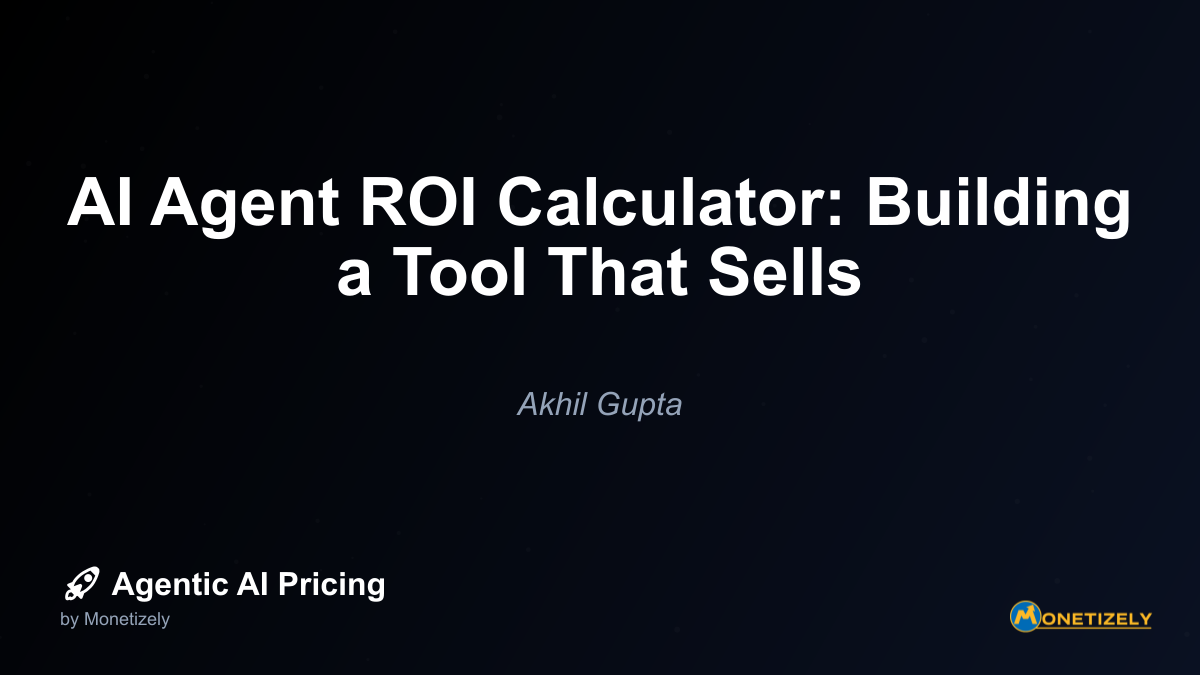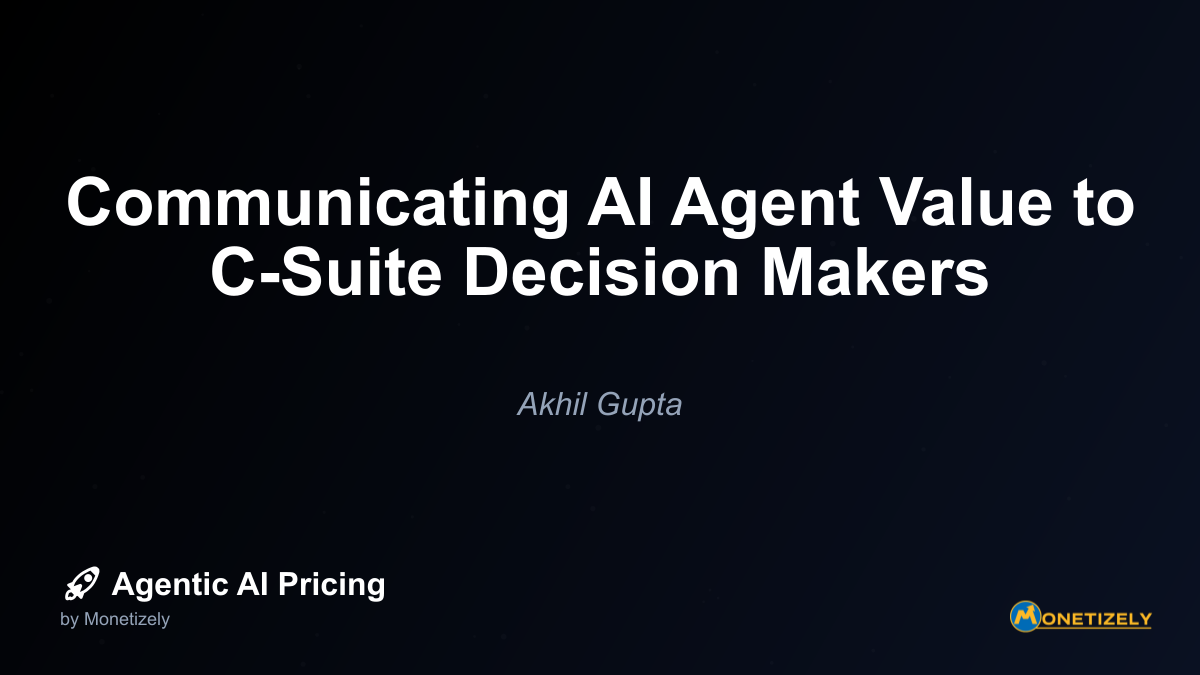· Ajit Ghuman · Communication & Messaging · 9 min read
Building Effective AI Pricing Calculators: UX and Backend
AI and SaaS Pricing Masterclass
Learn the art of strategic pricing directly from industry experts. Our comprehensive course provides frameworks and methodologies for optimizing your pricing strategy in the evolving AI landscape. Earn a professional certification that can be imported directly to your LinkedIn profile.

In today’s dynamic AI marketplace, pricing calculators have emerged as essential tools for both vendors and customers navigating complex pricing structures. These interactive interfaces transform intricate pricing models into digestible, self-service experiences that empower customers while reducing sales friction. For companies deploying agentic AI solutions, well-designed calculators serve as critical touchpoints in the customer journey, balancing transparency with strategic value communication.
Why AI Pricing Calculators Matter
The unique characteristics of agentic AI solutions—variable usage patterns, diverse deployment options, and multi-dimensional value metrics—create pricing complexity that traditional static pricing pages struggle to convey. Modern buyers expect self-service options for understanding costs before engaging with sales teams, making interactive calculators increasingly vital components of the purchasing process.
Research from Monetizely’s 2023 B2B SaaS Pricing Study found that 76% of enterprise buyers abandon purchase considerations when pricing transparency is lacking, while interactive pricing tools increase conversion rates by an average of 31% for complex AI solutions. These calculators serve multiple strategic functions:
- Qualifying prospects by setting appropriate price expectations
- Educating users about value drivers and pricing dimensions
- Reducing sales cycle friction by answering basic pricing questions
- Gathering valuable data about customer preferences and priorities
- Differentiating offerings through transparent value communication
Core Components of Effective AI Pricing Calculators
The most successful AI pricing calculators balance simplicity with accuracy, providing meaningful estimates without overwhelming users with complexity. They typically include:
1. User-Friendly Interface Elements
The calculator’s frontend must prioritize intuitive interaction through:
- Clear input mechanisms: Sliders, dropdowns, and toggle switches that allow users to adjust variables without confusion
- Real-time updates: Instant recalculation as users modify inputs to create an interactive experience
- Visual feedback: Graphs, charts, or visualizations that illustrate how changes impact pricing
- Mobile responsiveness: Seamless functionality across devices and screen sizes
- Accessibility compliance: Design that accommodates users with disabilities
2. Strategic Input Parameters
The selection of which variables to expose requires careful consideration:
- Usage metrics: Volume-based inputs (API calls, tokens, compute hours) relevant to your specific AI service
- Feature toggles: Options to add or remove capabilities that affect pricing
- Scale dimensions: User counts, storage requirements, or other scaling factors
- Deployment options: Cloud, on-premises, or hybrid configurations with associated cost implications
- Service level selections: Support tiers, SLAs, or performance guarantees
3. Backend Calculation Logic
Behind the interface lies the critical pricing logic that must:
- Accurately reflect actual pricing models: Calculations should align with your true pricing structure
- Handle complex interdependencies: Account for volume discounts, feature bundling, or usage thresholds
- Process edge cases: Manage minimum commitments, maximum caps, or unusual configurations
- Maintain calculation speed: Deliver results quickly even with complex formulas
- Enable easy updates: Allow for pricing model adjustments without extensive recoding
4. Output Presentation
How results are displayed significantly impacts user comprehension:
- Transparent breakdowns: Itemized costs showing how different selections contribute to total price
- Multiple timeframes: Monthly, annual, and multi-year projections where relevant
- Comparative views: Side-by-side package comparisons highlighting differences in value
- Savings callouts: Explicit presentation of discounts, economies of scale, or long-term savings
- Clear next steps: Prominent calls-to-action based on calculated results
Design Principles for AI Pricing Calculators
Creating effective calculators requires balancing several competing priorities:
Simplicity vs. Accuracy
The fundamental tension in calculator design lies between making tools simple enough for users to understand while providing sufficiently accurate estimates. Research from the Nielsen Norman Group suggests that abandonment rates increase by approximately 25% for each additional input field, yet oversimplified calculators can produce misleading results.
To balance this tension:
- Begin with minimal inputs covering the most impactful pricing variables
- Offer “advanced options” that users can expand for greater precision
- Provide clear explanations of assumptions made in simplified calculations
- Consider tiered calculator experiences (basic, advanced, custom) for different user needs
Transparency vs. Strategic Ambiguity
While transparency builds trust, complete pricing disclosure isn’t always strategically optimal for complex AI solutions. Effective calculators navigate this balance by:
- Clearly communicating the primary cost drivers while maintaining flexibility on final pricing
- Including appropriate disclaimers about estimates vs. contractual pricing
- Focusing on value metrics alongside cost figures
- Providing ranges rather than precise figures where appropriate
- Offering “request custom quote” options for complex scenarios
Educational Value vs. Conversion Focus
Calculators serve dual purposes as both educational tools and conversion mechanisms. The best designs:
- Incorporate subtle educational elements explaining pricing concepts
- Use tooltips and contextual help rather than lengthy explanations
- Include links to more detailed resources for interested users
- Maintain focus on the core calculation experience
- End with clear next steps based on calculated results
Technical Implementation Approaches
The technical architecture of pricing calculators varies based on complexity, integration needs, and security considerations:
Frontend Options
Modern calculator implementations typically leverage:
- JavaScript frameworks (React, Vue, Angular) for responsive, dynamic interfaces
- Interactive visualization libraries (D3.js, Chart.js) for graphical representations
- Form validation libraries to ensure proper input formatting
- CSS frameworks (Tailwind, Bootstrap) for consistent styling and responsive design
- Accessibility tools to ensure compliance with standards like WCAG 2.1
Backend Considerations
The calculation engine can be implemented through:
- Client-side calculation: JavaScript handling all logic in the browser (faster, but exposes pricing formulas)
- Server-side processing: API calls to protected calculation endpoints (more secure, but potentially slower)
- Hybrid approaches: Basic calculations in-browser with complex scenarios handled server-side
- Serverless functions: Cloud functions handling calculations without dedicated infrastructure
- Integration with pricing systems: Direct connections to CPQ or billing systems for complete accuracy
Data Management
Calculator data flows require thoughtful handling:
- User input persistence: Saving configurations for later reference or sharing
- Analytics integration: Capturing usage patterns and popular configurations
- CRM connection: Passing calculator results to sales systems for follow-up
- Security considerations: Protecting proprietary pricing information
- Compliance requirements: Handling user data according to relevant regulations
Implementation Best Practices
Beyond the technical architecture, several implementation practices separate exceptional calculators from merely functional ones:
Progressive Disclosure
Rather than overwhelming users with all options immediately, implement a staged approach:
- Begin with the most essential 3-5 inputs that drive 80% of pricing variability
- Allow users to expand sections for additional configuration options
- Save complex scenarios or enterprise-specific options for later stages
- Use conditional logic to show only relevant inputs based on previous selections
Contextual Guidance
Help users understand both how to use the calculator and interpret results:
- Provide input-specific guidance through tooltips or help text
- Include benchmark information where appropriate (“typical for your industry”)
- Offer comparison points for different configurations
- Explain the assumptions behind calculations
- Include mini-case studies showing how similar customers configured their solutions
Mobile Optimization
With approximately 30% of B2B research now conducted on mobile devices, ensure your calculator functions effectively on smaller screens:
- Redesign input methods for touch interfaces (larger touch targets)
- Simplify visualizations for mobile viewing
- Consider a progressive mobile experience with fewer initial options
- Test thoroughly across device types and screen sizes
- Ensure tap targets meet accessibility guidelines (minimum 44×44 pixels)
Performance Optimization
Slow calculators frustrate users and increase abandonment:
- Minimize HTTP requests for calculator resources
- Implement efficient calculation algorithms
- Consider precomputation of common scenarios
- Use browser caching effectively
- Implement loading indicators for server-side calculations
Testing and Optimization
Launching a calculator is just the beginning—continuous improvement through testing is essential:
User Testing
Before public release, conduct thorough testing:
- Usability sessions: Observe real users attempting to configure realistic scenarios
- Cognitive walkthroughs: Have evaluators work through specific tasks step-by-step
- Accessibility audits: Ensure compliance with accessibility standards
- Cross-browser testing: Verify functionality across browser environments
- Performance testing: Measure load times and calculation speed
Post-Launch Analytics
Once live, monitor key metrics:
- Completion rates: Percentage of users who finish the calculation process
- Time-to-completion: Duration users spend configuring options
- Drop-off points: Specific steps where users abandon the process
- Popular configurations: Common selections and option combinations
- Conversion rates: Percentage of calculator users who take next steps
Iterative Improvement
Use gathered data to drive ongoing enhancements:
- A/B test alternative input methods or visualization approaches
- Simplify sections with high abandonment rates
- Add explanatory content around frequently misunderstood options
- Adjust default values based on popular configurations
- Update calculation logic as pricing models evolve
Common Pitfalls to Avoid
Even well-intentioned calculator implementations often encounter these challenges:
Overwhelming Complexity
Many calculators fail by presenting too many options upfront. Research indicates that each additional input field reduces completion rates by 5-10%. To avoid this:
- Limit initial inputs to the most essential factors
- Use progressive disclosure to reveal additional options
- Provide templates or starting points for common scenarios
- Include “recommended” options for typical use cases
Misleading Simplicity
Conversely, oversimplified calculators can create unrealistic expectations:
- Be transparent about which factors are included and excluded
- Clearly label estimates versus guaranteed pricing
- Provide appropriate ranges rather than precise figures for variable costs
- Include disclaimers about additional factors that may affect final pricing
Poor Mobile Experience
Despite increasing mobile usage in B2B research, many calculators remain desktop-focused:
- Design mobile-first rather than adapting desktop experiences
- Replace sliders with more touch-friendly input methods on small screens
- Simplify visualizations for mobile viewing
- Ensure text remains readable without zooming
Inadequate Guidance
Users often abandon calculators when they don’t understand what inputs to provide:
- Include clear labels and descriptions for all input fields
- Provide reasonable default values based on typical usage
- Offer examples of how to determine appropriate values
- Include contextual help explaining unfamiliar terms or concepts
Case Studies: Effective AI Pricing Calculators
OpenAI’s Token Calculator
OpenAI’s token pricing calculator effectively handles the complex relationship between model selection, token volume, and pricing:
- Strengths: Clear visualization of token consumption across different models, interactive adjustments with real-time updates, transparent display of savings at different volume tiers
- Learning opportunity: The integration of educational content explaining what tokens are and how they relate to typical usage scenarios
AWS SageMaker Pricing Calculator
Amazon’s approach to ML infrastructure pricing demonstrates effective handling of multi-dimensional pricing:
- Strengths: Granular control over instance types, training hours, and deployment options with instant recalculation, comparative views showing cost differences between configurations
- Learning opportunity: The use of “typical scenario” templates that help new users understand common configurations
Dynamic AI Pricing Implementations
Companies implementing dynamic pricing models face particular challenges in calculator design:
- Strengths: Effective communication of value-based pricing concepts, clear explanation of how usage patterns affect pricing, transparent handling of variable factors
- Learning opportunity: The balance between providing meaningful estimates while maintaining flexibility for dynamic adjustments
Building Calculators for Different AI Pricing Models
The calculator design should reflect your underlying pricing model:
Usage-Based Calculators
For consumption pricing models (API calls, tokens, compute hours):
- Focus on volume tiers and associated discounts
- Include average consumption patterns for typical use cases
- Provide monthly and annual projections based on expected growth
- Consider incorporating seasonal variation for applicable industries
- Include options for commitment-based discounts versus pure pay-as-you-go
Seat-Based Calculators
For user-based pricing models:
- Include role-based pricing differentials where applicable
- Show economies of scale as user counts increase
- Incorporate feature access differences between user tiers
- Consider mixed licensing models (admin vs. regular users)
- Include deployment options that affect per-user pricing
Value-Based Calculators
For outcome-based pricing models:
- Focus on ROI calculations alongside pricing
- Include industry-specific value benchmarks
- Provide comparative scenarios showing value differences
- Incorporate risk-sharing elements where pricing varies with outcomes
- Consider interactive case studies showing realized value
Conclusion: The Future of AI Pricing Calculators
As AI solutions grow more complex and customizable, interactive pricing tools will become increasingly sophisticated. Emerging trends point to several developments on the horizon:
- AI-powered recommendation engines suggesting optimal configurations based on stated goals
- Integration with actual usage data for existing customers considering upgrades
- Collaborative configuration allowing multiple stakeholders to contribute to pricing scenarios
- Augmented reality presentations of complex pricing dimensions for enterprise solutions
- Digital twin modeling simulating how AI solutions would perform in specific environments
For organizations developing agentic AI solutions, investing in well-designed pricing calculators delivers multiple benefits: reduced sales friction, improved lead qualification, enhanced customer education, and valuable market intelligence. By following the principles outlined in this guide, companies can create calculator experiences that balance simplicity with accuracy while effectively communicating their unique value proposition.
The most successful implementations will continue to be those that recognize pricing calculators not merely as transactional tools but as strategic assets in the customer education and acquisition process—transforming pricing complexity from a barrier to a competitive advantage.
Co-Founder & CEO
Ajit is the author of Price To Scale, a top book on SaaS Pricing and is the Founder of Monetizely. Ajit has led and worked in pricing and product marketing at firms like Twilio, Narvar and Medallia. His work has been featured in Forbes and VentureBeat. Ajit regularly consults with software companies from Seed stage to post-IPO on pricing strategy. Ajit is also a highly-rated co-instructor for 'The Art of SaaS Pricing and Monetization' on Maven.
Pricing Strategy Audit
Let our experts analyze your current pricing strategy and identify opportunities for improvement. Our data-driven assessment will help you unlock untapped revenue potential and optimize your AI pricing approach.




